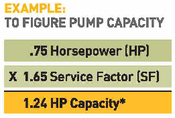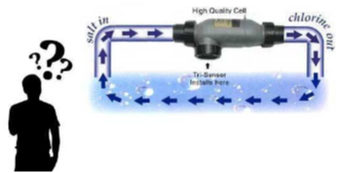|
As a swimming pool owner, you are guaranteed to run into some sort of problem with your pool from time to time. With regular maintenance and inspection, you can usually catch problems in the beginning stages before they become bigger more expensive problems. Your pool is fun, your pool is also an investment and requires maintenance. Regular routine swimming pool maintenance preferably by a professional is advised to prolong the life of your swimming pool. A large majority of pool problems are caused by lack of maintenance or improper maintenance. EXCESSIVELY ROUGH POOL SURFACE
This can be caused by many different things, the most common being poor water chemistry over a prolonged period of time. Concrete and pebble pools can have different finishing techniques and materials used which can also cause the surface to feel rough on your feet. Improperly balanced pH, improper alkalinity aggressive fill water, acid rain, high calcium hardness in the water, improper pool plaster starts up techniques, craze cracks, plaster delamination pitting, and calcium nodules are all possible scenarios that would cause a rough pool surface, this is why it’s so important to have your pool and it’s chemistry monitored and adjusted weekly by a pool professional who is trained and educated to look out for and correct these issues before they becoming big expensive problems. STRUCTURAL CRACKING A separation or crack in plaster and or concrete shell of the pool. Most commonly due to ground movement and improper design and or improper construction techniques. A swimming pool must be engineered and constructed to withstand unstable or expansive soil and built to the specifics of the soil sample that should be obtained and analyzed prior to construction. If not built in accordance to the engineering or according to the design a pool may structurally fail and leak water. PLASTER CRACKING & DELAMINATION small hairline plaster surface cracking referred to as craze cracking is most commonly due to improper application of the swimming pools plaster surface and an improper mix of the surface plaster. Most commonly too much calcium carbonate added to the mix which causes shrinkage of the plaster. This calcium is added to the plaster to increase its drying time and hardness. These surface cracks can promote algae growth, staining, and produce calcium nodules eventually resulting in the need to completely remove and replace the swimming pools surface. DISCOLORATION / MOTTLING (blotchy pool surface) Due to swimming pool plaster’s porous nature it is susceptible to staining. Pauses while filling the pool can leave a ring around the waterline, improper trawling techniques while the plaster is being installed, improper water chemistry, filling a pool too soon, improper mix of plaster being applied can all cause spotting and mottling in your pool. There are also many many different factors and causes of staining, from organic material such as leaves and dirt sitting on the pools plaster for a period of time, metal stains from fill water and improperly balanced water chemistry, copper from plumbing and heater elements, foreign objects being left on the pools surface. Sequestrants and stain removers can be used to effectively treat surface staining. ALGAE / GREEN POOL Probably the most common problem pool owners are familiar with, most commonly due to improper circulation, not enough circulation and or improper water chemistry balance, low sanitizer. Using a chlorine based shock and elevating the chlorine level 3x-5x the normal and a clean filter will solve this problem. CLOGGED FILTER / LOW CIRCULATION As your filter does its job it builds up pressure by trapping the dirt and organic waste in the filter, eventually it can’t filter anymore and needs taken apart cleaned and recharged. Don’t worry this is a good thing. A normal filter on a normal size pool should be cleaned and recharged 3-4x a year CLOUDY / TURBID WATER I’d say cloudy turbid water is one of the trickiest of problems to diagnose, could be cause by a dirty filter, rain, low chlorine, heavy use, usually resolved within a couple hours with proper treatment. This problem usually arises after heavy rains dilute the pools chemistry or the first couple weeks of summer when the summers hot sun starts to evaporate the free available chlorine in your pool. Cyanuric acid (conditioner) is needed in the warm months to protect the pools chlorine reserve and stop the suns UV rays from zapping your chlorine right out of your pool. The solution is to maintain 50-70ppm cyanuric acid and 3-5ppm chlorine level. A cloudy looking pool is the pools way of telling you something is unbalanced asking you for help before it gets really bad. Let’s make a big splash with energy savings. If you like money, please keep reading! Owning and operating a pool can have a huge impact on your homes electrical consumption. In My lifetime I have never witnessed energy rates go down and I don’t expect them to every go down. What I do expect is the utility rates to increase annually. The old Standard single speed pool pump is a thing of the past, although they have been in use in the pool and spa industry for decades, being the least expensive of pumps, they are also the loudest and cost the most amount of money to run every day averaging in some cases $2000 dollars a year to run 8 to 12 hours every day on a single speed. Imagine driving your car everywhere you go with the gas pedal smashed to the floorboard. You are going to waste a lot of gas. A single speed pool pump is the gas guzzler of pool equipment consuming huge amounts of electricity every day. It only has one speed, pedal smashed to the floorboard. Although you and your car might be in a hurry to get somewhere, your pools water is in no hurry to get thru the filtration cycle. This is what we pool professionals call a turnover rate. The turnover rate is defined as the amount of time it takes all of the water in your pool to go thru the filter. However not all of the water is passed thru the filter in a single turnover. The filtered water is returned to the pool where it mixes with unfiltered water. This substantially increases the time and number of turnovers needed to filter ALL the water in your pool. FOUR turnovers per day are what is required by many local health codes on commercial pools. Weather you get there in 6 hours or 16 hours the results are the same, so why rush it.  The Variable Speed pool pump is a modern marvel. It was introduced to the pool and spa industry in the early 2000’s. Unlike the old induction motors of single speed pump motors, variable speed pumps use a TEFC (totally enclosed fan cooled permanent magnet motor. This is the very same type of motor used in today’s modern electric vehicles. These new motors are computer controlled and allow the user to dial in the most efficient speed and flow rate for the pools application. As you may have read in prior blogs no two pools are the same, no two pools have the same hydraulic characteristics. By running the pump at a lower speed, you are reducing the work the motor does, reducing the amount of electricity it consumes.  The golden rule of hydraulics is “slower is better”. Running the pump at a lower speed allows the hydraulic system to run more efficiently, produce less friction, runs quieter, the pump lasts longer. In most cases you will see an annual savings of 75%-90% on your pool pumps electrical consumption. A variable speed pump will greatly improve your pools filtration. The performance of your pool filter improves when water flows thru it more slowly, this increases the opportunity for particle removal. This will translate into less filtration time even at a lower speed leading to even more energy savings. We achieve this determining factor by performing an energy audit to show you exactly how much money you are going to save by installing a variable speed pool pump on your pool. Your average return on investment is above 400% over 5 years.  In many states as it is the case in California they have adopted energy-efficiency regulations regarding the sale and installation of inefficient, costly-to-operate pumps and motors. The California Energy Commissions “Appliance Efficiency Regulations” (Title 20) prohibit the sale and installation of singles speed residential pool filtration pumps or replacement motors with a capacity of one total horsepower or above. To the homeowner this means basically if you have more than ½ horsepower pump it’s now become illegal to replace that motor or pump with an equal rated replacement motor or pump. You are required to replace the pump or motor with a new energy efficient variable speed pump. Federal regulations are set to start in the year 2020 that all pool pumps must be variable speed. A single speed motor or pump is a dying breed.  If you need a new pump, and if you don’t already have a variable speed pump believe me when I say YOU NEED THIS PUMP, or simply want to reduce your energy costs, this is a great time to purchase a variable-speed pump or motor. Qualifying products can yield large rebates from utility companies of up to $1000 dollar, also a large majority of manufactures of these variable speed pumps are also offering homeowners of residential pools that purchase a new variable speed pump additional consumer rebates of up to $100 dollars. Key benefits of installing a variable speed pump
Tips for Installing a variable speed pump: Call a professional! Professional pool technicians are trained and understand your pools hydraulic system, they know the best settings and programming for the most energy efficiency, replacing an existing pool pump with a variable speed requires electrical and hydraulic knowledge, this is not something you want to try and do yourself. These are expensive highly complex pieces of equipment and in most cases in order to qualify for manufacturer's warranty and utility rebates these pumps must be installed by a licensed certified aquatic equipment installer. Need a hand? Want more info? Give us a call today. Dive in and control your energy bills. What’s a Salt System? You’ve heard the term, you probably know someone that has one, but you are still not sure what a salt system pool is. A “salt system” is a pool with salt water chlorine generation. It is a method of producing a constant supply of natural chlorine to your pool thru electrolysis. Every swimming pool requires a form of sanitization to remain healthy and clean. Chlorine has been the Industry standard for decades primarily due to its abundant supply and low cost. Now you no longer have to store harmful chemicals at your home. Innovation and advancements in technology for your pool equipment has given us ECG or Electrolytic chlorine generators also referred to as SCG or Salt Water Chlorine Generation. A process where a piece of equipment ( salt cell) is installed in your pools circulation plumbing system and the introduction of salt into your pool water produces chlorine. I know what you are thinking, wait, I thought salt water pools are not chlorine pools. That is a misconception the pool industry has been battling for decades. For a majority of pool owner’s just simply knowing salt water goes in and chlorine comes out is efficient but let’s take a deeper look into how this process works.
Converting your current pool to a salt water chlorination pool does require some financial investment which can worry some pool owners. However If you compare the cost versus the price you are going to save big in the long run. Some benefits of salt water chlorination are: Some disadvantages of converting to salt water chlorination: Initial expense: initial equipment cost, but after installation you save money on not needing to purchase and store buckets of chlorine tablets and gallons of liquid chlorine. You save money in the long run. More complex : the need for routine maintenance: Like any piece of pool equipment it comes with a maintenance schedule just like your car does. It’s recommended by the manufacture to clean the salt cell (de scale) with a solution of muriatic acid and water every 3 months. This is something you want a trained skilled professional to do. Wear and tear: Salt is corrosive, some pool owners have expressed concerns of the salt and the electrolysis process prematurely wearing out other pieces of equipment in their pools such as hand rails and heat exchangers and solar water heating systems lights and the masonry around their pool deck due to salt and electrical exposure. Although this is possible, it’s not likely if your system is running properly and not OVER PRODUCING chlorine. A sacrificial zinc anode and other measures can be put in place to prevent this. Water Balance: Management of pH level, with the addition of salt your pools water balance specifically the pH will tend to raise and will need adjusted more frequently. Is a Saltwater Pool Right for You?  A shimmering pool beyond the back door is a prerequisite for many new homeowners. Whether cooling off, swimming workout laps or using it as a beautiful party backdrop, residential pools are crucial to the modern lifestyle. Although saltwater pools have many positive points — particularly being environmentally friendly and healthier and safer — do your homework to see which type of sanitization system is right for you. |
AuthorWrite something about yourself. No need to be fancy, just an overview. Archives
August 2018
Categories
All
|
